FLY TYING TIP - FOAM STRIKE INDICATORS
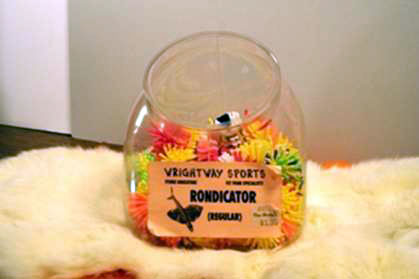
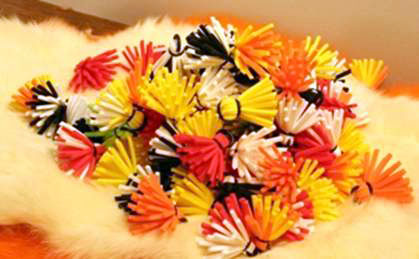
I have been a fly-fishing guide for a long time and I cannot count the number of times I have been in a fly shop and looked at the jar of foam strike indicators setting by the cash register. I have never been able to bring myself to make any of my anglers use anything that would hinder their casting. I once asked a guide I saw using this type of indicator, why? He replied, “Well the clients can see them and they will work with heavy nymphs.”
The clients can see them!!! Jeez’s----Stevie Wonder could see them. However, they hinder the casting, the large foam or even yarn strike indicators are very air resistance and cause problems with casting accuracy. Now add in beginning anglers and you have real problems, but I digress.
One day as I glanced at the jar of foam strike indicators, I realized that, “No I didn’t want to use them as indicators, but yes, I could use them for fly tying.”
If you will look closely, you can see that if you carefully cut the small rubber O Ring that doubles the foam pieces, that you have fourteen sections per side of dry cell fly foam that can be used in many different ways to construct effective imitations. These are very precise strips of foam that are bundled to together to form the indicator, I also realized that they cost $1.35 to $1.50 each making them a steal for the savvy fly tier.
What follows is just a small selection of the various patterns that can be constructed using Foam Strike Indicators.

INDICATOR FOAM SPIDER
- HOOK: TIEMCO 2487 SIZES: 10-16
- THREAD: OLIVE DUN 6/0 OR 8/0 LEGS:8 PER SIDE, 4 CENTIPEDE
- LEGS SPECKLED BROWN & 4 SPECKLED ORANGE, BY USING THE THREAD YOU CAN MAKE THEM SPLAYED OUT IN A CIRCLE AROUND THE HOOK. ON SIZES 10 & 12 USE MEDIUM SIZED LEGS AND ON SIZES 14 & 16 USE SMALL SIZED LEGS, LEAVE THEM LONG SO THEY WILL DANCE ON THE SURFACE TO THE WATER.
- FOAM TOP: FIRST TIE DOWN A STRIP OF BLACK FOAM AND THEN LAY DOWN A STRIP OF CHARTREUSE FOAM ON TOP AND THEN TAKE FOUR OR FIVE WRAPS OF THREAD AROUND THE BASE OF THE FOAM LIKE YOU DO WITH A PARACHUTE POST
- BODY: DUBBED, SCINTILLA #46 PEACOCKLE, AROUND THE BASE OF THE FOAM AND IN FRONT AND BEHIND IT.
NOTES: I have tied this spider in many different colors. This pattern works well in the late summer on rivers, stillwaters and spring creeks. Just use a slight twitching motion, that and the natural motion imparted by the wind and currents make it a hard pattern for the trout to ignore.

INDICATOR FOAM YELLOW HOPPER
- HOOK: DAI-RIKI # 280 SIZES: 10-20
- THREAD: OLIVE DUN 8/0
- BODY: TAKE A SINGLE STRIP OF YELLOW FOAM, SEAR THE TIP AND ROLL, TIE IT DOWN 2/3 OF THE WAY UP THE HOOK SHANK, LEAVING A PORTION EXTENDS BACK FOR THE BODY AND FORWARD FOR THE HEAD.
- UNDERWING: NATURAL LITE ELK HAIR
- WING: MOTTLED TAN HOPPER WING MATERIAL, CUT TO SHAPE
- LEGS: TWO PER SIDE, SPECKLED YELLOW CENTIPEDE LEGS, TIED MADAM X STYLE
- THORAX: DUBBED SCINTILLA #15 PALE YELLOWY/OLIVE, DUBBING BETWEEN THE LEGS.
- EYES: PLACE A DOT ON EITHER SIDE OF THE HEAD USING A BLACK MARKER
NOTES: The foam strip take a marker very well, therefore you can tie hoppers in many effective colors. However do not overlook tying a few in the chartreuse barred with an olive marker. The Chartreuse Hopper works very well on rivers of Yellowstone National Park. This is a fast little hopper imitation to tie and beside it just cute!
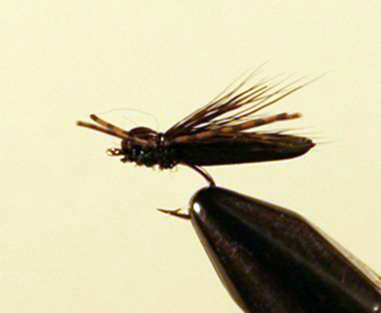
INDICATOR BLACK FOAM CRICKET
- HOOK: DAI-RIKI #125 SIZES: 12-18
- THREAD: BLACK 8/0
- BODY: A STRIP OF BLACK FOAM, SEAR THE TIP AND ROLL IT
- HEAD & WING: BLACK DEER, TIED HALF-BULLET HEAD STYLE
- HEAD: DUBBED, ICE DUB BLACK
- LEGS: TWO PER SIDE, BROWN SPECKLED CENTIPEDE LEGS TIED MADAM X STYLE
NOTES: There is no doubt in my mind that cricket imitations are among one of the most under utilized patterns in the west. However, crickets are very effective on the rivers, spring creeks and stillwaters. You can easily give a hot top your cricket by adding a small section of bright foam to the top of the pattern. This is another fast and easy pattern to tie.
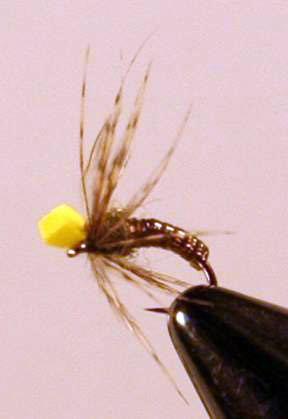
INDICATOR CADDIS EMERGER OLIVE BROWN
- HOOK: TIEMCO 2487 SIZES: 10-20
- THREAD: OLIVE DUN 8/0
- FOAM POST: SECTION OF YELLOW FOAM, TIED ALMOST TO THE EYE OF THE HOOK, LEAVE JUST ENOUGH ROOM FOR A FEW WRAPS OF THREAD AND THE WHIP FINISH BETWEEN THE FOAM AND THE EYE OF THE HOOK
- ABDOMEN: ULTRA LACE OLIVE/BROWN WRAPPED
- THORAX: DUBBED, SCINTILLA #65 DARK OLIVE BROWN
LEGS: BROWN MOTTLED BACK FEATHER FROM A HUNGARIAN PARTRIDGE, TWO OR THREE WRAPS
NOTES: This pattern can be fished alone, though it is hard to see in the surface film. My favorite method is to fish it as dropper behind something I can see, and allow the imitation to swing before I recast. Here again this pattern can be tied in a number of color combinations to match the emerging caddis on the waters you are fishing.
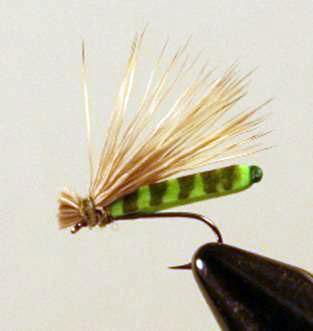
INDICATOR ELK HAIR FOAM CADDIS ADULT
- HOOK: DAI-RIKI #300 SIZES: 10-20
- THREAD: TAN 8/0
- BODY: STRIP OF CHARTREUSE FOAM, SEAR AND ROLL THE TIP AND MARK THE BODY WITH BROWN BARS
- WING: NATURAL LITE ELK HAIR, TIED ELK HAIR CADDIS STYLE, WITH JUST THE SMALLEST AMOUNT OF SCINTILLA #30 PALE OLIVE BROWN DUBBED UNDER THE WING BASE AND OVER WHERE THE ELK HAIR WAS TIED DOWN.
NOTES: This is one of the most effective and easiest dry caddis patterns to tie that I know about. This can be tied in many different colors and due to it simple body and wing it floats very well. This style has become my favorite dry for the famed Mother’s Day Caddis Hatch on the Yellowstone and Lower Madison Rivers.
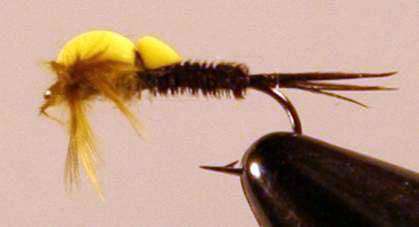
INDICATOR FOAM PT NYMPH EMERGER
- HOOK: DAI-RIKI #300 OR #305 SIZES: 10-18, 14-22
- THREAD: BROWN 8/0
- TAILS: PHEASANT TAIL FIBERS, DYED OLIVE
- WINGCASE: STRIP OF YELLOW FOAM TIED IN AT THE EYES OF THE HOOK, AFTER THE IMITATION IS COMPLETE YOU FOLD THE STRIP BACK AND TIE IT OFF AT THE REAR EDGE OF THE THORAX
- RIB: REVERSE WRAP, ULTRA FINE DARK, ULTRA THREAD
- ABDOMEN: PHEASANT TAIL FIBERS, DYED OLIVE, TIED IN BY THE TIPS AND WRAPPED FORWARD
- LEGS: TIE IN AN OLIVE AFTERSHAFT FEATHER AND WRAP
- THORAX: DUBBED, SCINTILLA #30 PALE OLIVE BROWN
NOTES: This pattern style can be used to imitate any number of different mayfly species by matching the material colors to match the naturals. This pattern can also be tied on a Tiemco 2487.

INDICATOR MIDGE EMERGER, OLIVE & BLACK
- HOOK: TIEMCO 2487 SIZES: 14-22
- THREAD: BLACK 8/0 OR 12/0
- WINGPOST: STRIP OF WHITE, YELLOW OR ORANGE FOAM, TIE IN ON THE TOP OF HOOK SHANK, JUST IN BACK OF THE EYE
- ABDOMEN: STRIPPED GRIZZLY HACKLE FEATHER, DYED CHARTREUSE, TIED IN BY THE TIP AND WRAPPED FORWARD IN TIGHT SIDE BY SIDE WRAPS
- THORAX: DUBBED, BLACK ICE DUBBING
- HACKLE: NATURAL GRIZZLY DRY FLY HACKLE, TIED PARACHUTE STYLE
NOTES: This pattern can be tied in many different colors to match the naturals on the waters you are fishing. This pattern may also be tied with a trailing shuck.
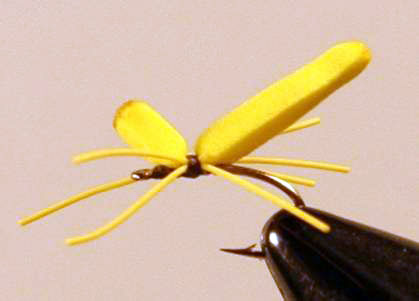
INDICATOR YELLOW BLUEGILL BUG
- HOOK: DAI-RIKI #125 SIZES: 12-16
- THREAD: OLIVE 6/0 OR 8/0
- BODY & HEAD: STRIP OF YELLOW INDICATOR FOAM, SEAR AND ROLL BOTH TIP, THE BODY AND HEAD ARE TIED 2/3 OF THE WAY UP THE HOOK SHANK
- LEGS: TWO SETS OF TWO YELLOW RUBBER LEGS TIED DOWN EITHER SIDE OF THE HOOK
NOTES: This pattern is deadly on Bluegills. I also tie this pattern in white, black, chartreuse, tan and olive. Sometimes I will band the body with a marker and add eyes. On some of the patterns I will use speckled centipede legs. You are only bound by your own willingness to create. This is a fast, easy and effective pattern to construct. By the way it also is very effective on Bass and Trout. Trout in stillwaters seem to be very fond of this pattern.
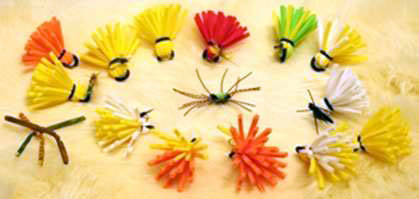
FOAM STRIKE INDICATORS COME IN MANY DIFFERENT COLORS.
One of the patterns that I didn’t show was a Foam Post Parachute Dry Fly. The foam strip could be used as the parachute post on any number of different mayfly imitations. I have also constructed imitations of ants and beetles using these foam strips as well as small stonefly adults. Now that you know about these neat little bundles of dry fly foam, go out and garb a handful and start creating your own effective imitations.
I really like the small hoppers and cricket that I can construct using these small foam strips. The patterns are simple yet durable and effective. As a strike indicator I think they are a strike out, but as a tying material, they are tops.
Enjoy & Good Fishin’ & have Fun Tying!
